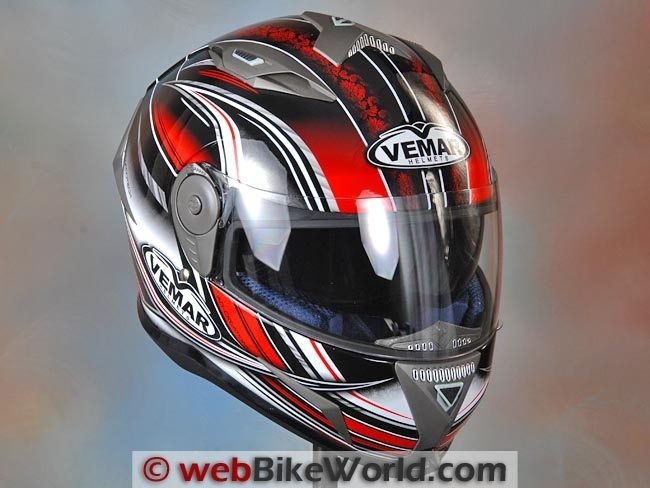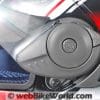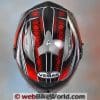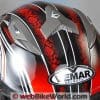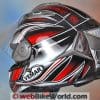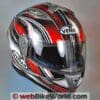The new 2012 Vemar Geo is a new mid-range helmet.
It features a “Tricomposite” shell with an angular design.
The intake and exhaust vent styling also makes the Geo stand out from the crowd.
The ventilation and visibility are good.
And the internal sun visor has about the best coverage of any we’ve tried.
The Vemar Geo is new for 2012 and it fits in at the mid-range position in the Vemar lineup.
It’s also somewhat of a “sleeper”, at least in the U.S.A.
By that I mean that it hasn’t received a lot of publicity, so you may have missed it if you were looking for a new helmet recently.
The mid-range motorcycle helmet market is a tough place to be. I’d define “mid-range” as having a price over $200.00 or so but less than, say, $400.00.
A helmet has to have a few special attractions to get the sub-$200 crowd to bite and the riders spending over $400.00 usually want one of the “prestige” brands, like Arai, Shoei, SCHUBERTH or others.
So what makes the Geo special? Well, most of those sub-$200 helmets have a polycarbonate shell.
Not that there’s anything wrong with polycarbonate, but the Geo has a “Tricomposite” shell, made from a “carbon fiber aramidic fiberglass blend”.
It also has a very nice internal sun visor that provides the type of coverage we’ve been wishing for.
And the Geo also has a particularly roomy shape that also makes it easy to pop on and off the head. Let’s take a closer look…
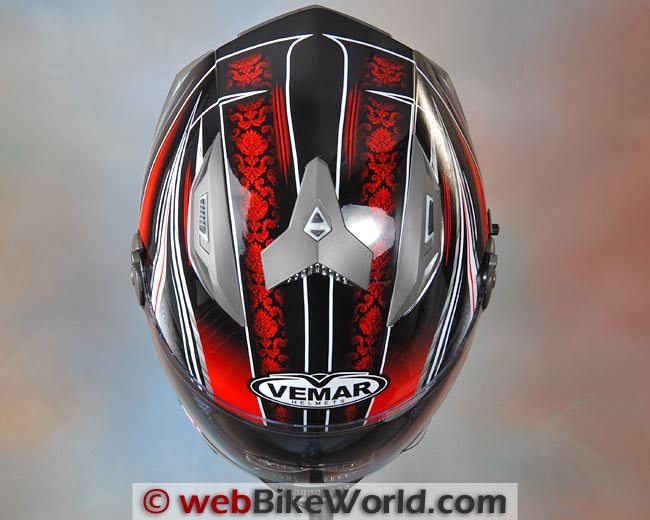
The Vemar Geo: Paint, Graphics and Overall Quality
The Geo is available in your basic white, silver or black (matte and gloss) or the “Cruel” graphics shown here in red, blue or black with white.
For some reason, the solid white version doesn’t seem to be imported into the U.S. and the Geo is not available anywhere in high-viz colors, such as yellow, orange or maybe a bright red.
I think the helmet would be a good candidate for the high-viz (or at least the viz) treatment, so maybe Vemar will take the hint. But, the Cruel graphics in red, black and white are probably visible enough though, some might say.
I’ll admit that the overall shell shape, the highly stylized vent treatments and the graphics may not be for everyone.
To be honest, when the Editor first handed it to me, I immediately thought it looked something like Buck Rogers or maybe even Ming the Merciless would wear on one of their 25th Century rides.
Problem is, if you’re old enough to remember them, you’re probably not in the target demographic that the designers had in mind for the Geo!
But the styling has grown on me since then and one thing’s for sure: this helmet stands out from those plain old smooth shell designs, no question about that.
While the graphics aren’t really that unusual and perhaps even reminiscent of motorcycle helmet design of the 20th Century — much less the 25th — the treatment is nicely done and the quality is good, consistent with the helmet’s list price.
Those chrome-tipped vent covers aren’t bad either and although the vent switches may seem a little loose, they actually feel pretty solid as they snap back and forth. And, they each have a soft rubberized and serrated insert which adds grip.
The liner padding and fabric is good quality, although nothing extraordinary and about what you’d expect at this price range.
When all is said and done, if you like the styling, then the Geo is actually a pretty good bargain because it gives you some extra spice for not a lot more than you might spend on one of those more pedestrian helmets.
Score: I’ll give the Vemar Geo a “Very Good” rating for paint and overall quality. See the Summary Table at the bottom of the page for a description of our rating system.
Vemar Geo Helmet Fit, Internal Shape and Liner
We’ve noted in many of our helmet reviews over the last year that the manufacturers seem to be converging — deliberately or not (probably not) — on a “Neutral” internal shape for many of their helmets.
Even Arai seems to have softened their shapes that used to run from one end of the head shape spectrum (“Long Oval”) to the other (“Round”; see the wBW Motorcycle Helmet Shapes page for more information).
Here’s where the Geo really is different — in a good way.
The helmet has what I’d call a “Round” internal shape, which is extremely rare and difficult to find in anyone’s 2012 helmet lineup. So all of you “Earth” shaped head owners (wider at the sides) should be very, very happy indeed.
But, that’s not to say that the Geo won’t fit that mythical “Neutral” head shape either.
In fact, I ran a bit of an experiment by handing the Geo over to fully a half-dozen riders with as many different head shapes, and all but those with the most narrow noggins said that the Geo was very comfortable and had a correct fit.
One of the interesting things about the Geo’s shell shape and internal fit is that they combine to make this helmet very easy to put on or take off.
So anyone with large ears or who is otherwise reluctant to squeeze their cranium into a full-face helmet should be pleased. It easily slips on or off and that’s a real pleasure.
I also have no problem at all easily slipping my reading glasses or sunglasses right into the Geo’s eye port and over my ears, and that is very unusual…and greatly appreciated.
Yet, with all this room, the helmet still feels correct — it’s not like it’s swimming on my head with my cranium being the clapper inside a bell.
So again, for riders with rounder-shaped head profiles who have found problems fitting a full-face helmet, or who normally feel a bit claustrophobic, or even those who find they have to frequently put the helmet on and take it off (dispatch riders?), the Geo is for you.
The bottom opening of the helmet feels wider than usual, which makes slipping on the helmet a completely un-painful experience. Nice.
The EPS foam liner inside also has deep molded channels, which help the air flow and also are double-density (claimed) to provide controlled “crushability”.
The Geo shell comes in two sizes and the head size range is realistic, running from S to XXL.
I’ll have to assume this size large is the larger shell size (but I’m not certain); if that’s the case, then perhaps the roomy fit is more pronounced because it would be the smallest head size in the larger shell.
But Vemar and Motonation (the U.S. importer), also make mention of the special roomy fit of the Geo, so I’ll also have to assume my findings hold true across the size range.
Vemar says the size large should fit a 59-60 cm head; I think that’s more like 60-61 cm. For sure a 59 cm head, unless it’s truly round or “Earth” shaped, would be a bit too small I think for the size large.
Otherwise, the padding and fabric of the removable liner are nice and comfortable, with the padding having a slightly firmer than average feel, which I like very much.

More information on helmet fit can be found in the webBikeWorld Motorcycle Helmet FAQ page.
Also, see the chart that lists the helmet weights of webBikeWorld reviewed helmets and also by shape on the webBikeWorld Motorcycle Helmet Shapes page.
Score: I’ll give the Vemar Geo an “Excellent” rating for fit, comfort and the roomy and round internal shape. The padding and liner feels comfortable and the helmet should fit motorcyclists with head shapes ranging from neutral to round.
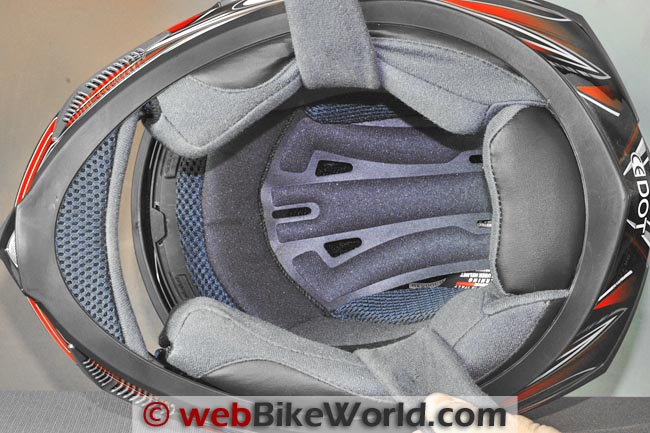
Vemar Geo Eye Port and Visibility
The visibility from the Vemar Geo seems about slightly better than average in the horizontal plane and about average in the vertical plane.
Actually, considering the internal shape of this helmet, the proportions and the distance of the rider’s head and eyes to the eye port are not affected at all, which I think is rather interesting and demonstrates a good design.
The eye port gasket doesn’t have any special lips, edges or molding; it’s your basic gasket that fully surrounds the eye port.
But the spring-loaded design of the face shield somehow allows it to snap tightly against the gasket, giving it a very good seal on our example, which passed the leak-down test.
The vents also seal tightly on this one in the rain, so the Geo may be a good candidate for wet-weather riding.
In fact, the face shield snaps home with a solid feel, so the different rotating mechanism design must be working as planned.
The lift tab though should definitely have been placed in the center of the face shield at the bottom.
That’s because the tight spring action of the rotating mechanism means that the face shield has quite a lot of twist or torque as it’s lifted from the tab in its current location, far to the left. The tab is also smaller than it should be.
But the system does give the 2.35 mm thick (slightly thicker than average) face shield a good feel as it rotates through the three detents, as long as you’re deliberate about it when you lift or close.
A too-gentle hand on the tab will cause the face shield to balk between detents, so the trick is when you lift or close, do it with gusto.
The face shield is also claimed to have been treated with an anti-scratch and anti-fog coating.
The removal system is definitely different; be sure to watch the video below to see how it works, because there were no instructions included in two different Geo boxes and we broke the first one by not understanding the correct procedure.
This face shield does not remove like you think it might, so don’t try to force it. It’s easy once you know how, albeit a bit complex.
Hint: do not try to remove the face shield when it is in the uppermost position, like you would for most other face shields! Watch the video to learn how.
Internal Sun Visor
I can state unequivocally that the internal sun visor in the Geo has the most coverage of any I’ve tried.
We have been critical of internal sun visors in the past, because they add weight and complexity to a helmet but mostly because the vast majority of these devices simply don’t perform as well as expected.
That performance problem is related to the area that the sun visor covers in front of the rider’s eyes.
Usually, the bottom edge remains annoyingly in the rider’s line of sight and/or the bottom edges at both sides are cut at an angle, also annoying.
Another common problem is the bottom edge is too curved or the cutout for the nose is ridiculously big, which also means all sorts of distractions for the rider.
The sun visor in the Geo has none of these problems. When engaged, it drops down about 77 mm from the top (~3″) and the lower edge is nearly straight, with just a slight downward bend or belly. A very small cutout for the nose is unnoticeable.
The visor also seems darker than the tea-tint usual. If you’re going to have a drop-down sun visor, then it should be dark enough to do something to prevent glare, but most are limited by various national laws regarding light transmission percentages.
Who knows — Vemar might be skirting the edges of legality, or perhaps the sun visor seems darker because of the excellent coverage. In any case, it works.
The only thing I can fault is the engagement lever.
It would be nice if the sun visor could be stopped in an intermediate position to darken the light above the eyes. But on the other hand, the short-travel lever on the left-hand side is a quick snap on-or-off proposition.
It makes the sun visor snap open or closed though with a fast action (illustrated in the video below), so in that regard, it works well.

Score: I’ll give the Vemar Geo a “Very Good” rating in this category. The internal sun visor gets an “Outstanding”.
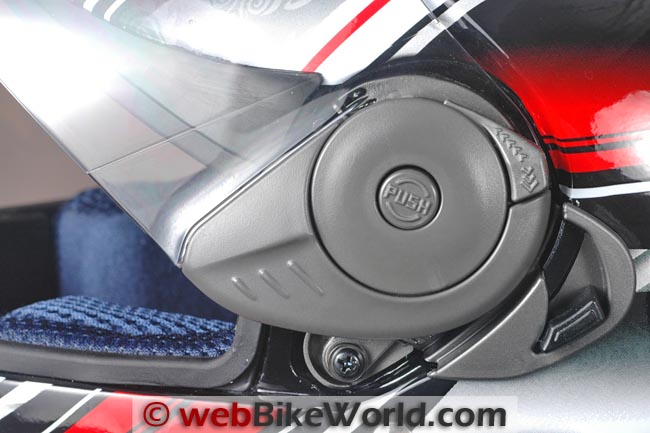
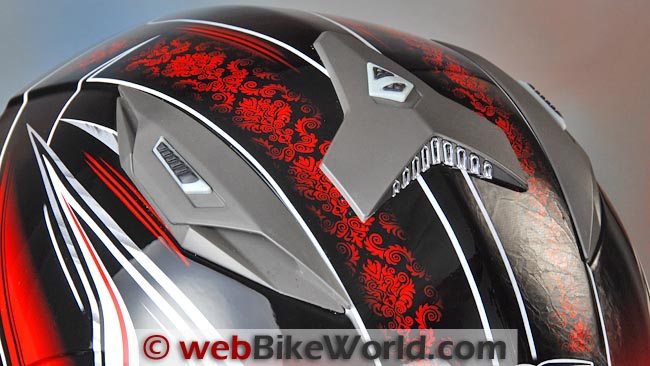
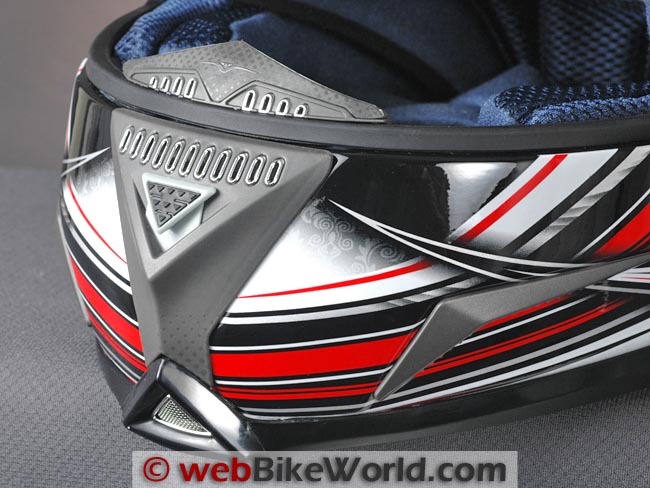
Vemar Geo Ventilation and Air Flow
The vent styling is what makes the Vemar Geo stand out from the crowd.
The styling of these vents may be a bit polarizing, but the vents seem to work as intended, although I believe you can thank only the large rear exhaust for that.
Look up inside, over the top of the helmet lining and you’ll see deep channels molded into the EPS. But, I can’t find any intake holes that direct air from the top vents into the helmet.
There is a large open section at the rear of the EPS though that appears designed to pull the air through the helmet and out the back.
The three vents on top have rubber-covered switchgear; the two side vents seem to flow air into the front of the vent assembly and out the back, without flowing any air down into the helmet.
I don’t know this for sure, but again, I don’t see any hole or ports inside the helmet and blowing through the front of the top side vents only seems to push air out the back of the vent.
The top center vent seems to move air into the helmet but above the EPS and then out the back through the exhaust. Three top vents are two too many, but understanding the system, it’s best to simply leave them on all the time and forget about them.
The chin vent switch can be slightly balky; it worked fine on the first Geo but it’s sticky on the second. Perhaps a shot of silicone spray would help.
There are no air passages through the chin bar, so the air flows through the chin vent and up along the top at a very narrow slit at the top of the chin bar and vestigial breath guard.
A small secondary opening at the bottom of the chin vent plastic assembly can be seen in the photo above. This one flows a small volume of air up through the vent also.
The Geo includes a small chin curtain underneath the chin bar and due to the wider design of the bottom of the helmet, some air does flow up from underneath but it doesn’t seem any worse than average.
Overall, I’d rate the Vemar Geo ventilation as average to slightly better than average, which is surprising, considering the absence of any internal vent holes that I can find.



Score: I’ll give the Vemar Geo ventilation system a “Very Good” rating.
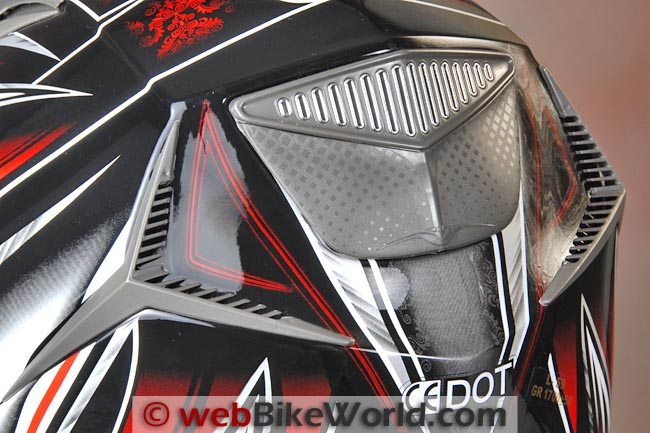


Vemar Geo Sound Levels
The Geo is about average when it comes to noise control. Considering the slightly larger bottom opening design of the shell and the roomy internal fit, this is actually good news.
There is no noise from the top vents, which reinforces my suspicion that there are no vent holes through the EPS (which could transmit noise).
Something I didn’t mention earlier is that the ear pockets in the Geo are very shallow and are mostly covered by liner. We didn’t try to fit speakers in the helmet, but I suspect it wouldn’t be difficult.
At one point, Vemar was going to offer a Bluetooth intercom system built into an accessory cheek pad kit but apparently that never came to fruition.
The design of the ear pockets and the extra liner material in that area perhaps helps reduce noise levels. There isn’t much wind noise from beneath the helmet either; surprising considering the shape, but it seems to work.
So overall I’d say that the noise levels of the Vemar Geo are about average, with some general wind noise around the helmet but no additional noise from the vents.



Note that our helmet evaluations are a combined effort of several riders over time on different types of motorcycles with and without windscreens.
Evaluators wear correctly fitted, high quality ear plugs (even when evaluating motorcycle intercom systems).
Always protect your hearing when riding a motorcycle. See the wBW Earplug Reviews for more information on choosing and wearing earplugs.
Note also that perceived noise levels will vary, depending on the individual.
Noise can be caused by many factors, including helmet fit, the type of motorcycle and windscreen, wind speed and direction and even the rider’s clothing.
For more information on helmet noise, visit the wBW Motorcycle Helmet Noise page.
Score: I’ll give the Vemar Geo a “Very Good” rating for average overall noise levels.
Helmet Weight
A funny thing about the Geo — pick up this size large and you’d think it weighs more than it really does.
The Vemar Geo shown here in size large weighs 1688 grams, actually not bad considering the rococo vent styling and internal sun visor.
Choosing some helmets at random that have been reviewed and listed on the wBW Motorcycle Helmet Weights page, the Vemar Geo compares to the similarly-shaped (internal) Bell Sprint (review) in size XL at 1688 grams and the SCHUBERTH C3 With SRC (review) flip-up in size large at 1692 grams.
Also the Bell Star 2010 (review) in size XL at 1696 grams. Not a bad showing actually.
The weight feels about normal when I’m wearing the helmet and once more, that roomy internal fit feels comfortable.
Note also that all of the helmets reviewed on webBikeWorld have been weighed and the weights are available on the wBW Motorcycle Helmet Weights page.
Also, see the chart that lists the helmets by weight and shape on the wBW Motorcycle Helmet Shapes page.
Score: The Vemar Geo gets an “Excellent” rating for average weight with good balance.



Miscellaneous
The Geo has a micro-lock chin strap locking system.
The padding under the chin strap is longer than average and the padding is comfortable. It also includes a metal D-ring for locking the helmet to the bike.
The Vemar Geo meets the DOT standard in North America and ECE in Europe.
The Geo has a five-year warranty, which effectively covers the helmet for its usable life and is somewhat of a bonus at the asking price.
| webBikeWorld Overall Opinionator: Vemar Geo | |
|---|---|
| Picks… | …and Pans |
|
|
Conclusion
The Vemar Geo remains more or less of the radar screens of many riders we think, but the street price actually makes it a pretty good deal, considering the competition that exists at lower prices.
For not much more than that $200.00 barrier that exists for many motorcyclists, you can get some styling, an outstanding internal sun visor and a composite shell.
I’ll take mine in white, yellow, orange or red…but unfortunately those colors either aren’t available in the U.S.A. In the meantime, the red “Cruel” graphics do the trick.
All things considered, the Vemar Geo should be on your short list if you’re in the market for a sub-$250.00 motorcycle helmet.
| wBW Review: Vemar Geo Helmet | |
|---|---|
| Manufacturer: Vemar Helmets | List Price: $275.00-$295.00 |
| Colors: Solids and graphics. | Made In: Vietnam |
| Sizes: XS-2XL Shell Sizes: 2 | Review Date: August 2012 |
|
Rating Scale is subjective: Unacceptable, Poor, Neutral, Very Good, Excellent, Outstanding.
|
|
Owner Comments and Feedback
See details on submitting comments.


